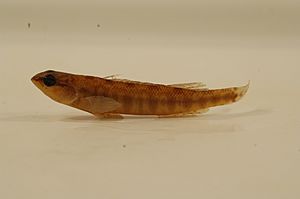Blackbanded darter facts for kids
Quick facts for kids Blackbanded darter |
|
|---|---|
 |
|
| Conservation status | |
| Scientific classification |
The blackbanded darter (Percina nigrofasciata) is a small, freshwater fish. It's a type of ray-finned fish and belongs to the Percidae family. This family also includes perches and pikeperches. Blackbanded darters live in rivers and streams in the southeastern United States. You can find them in states like South Carolina, Tennessee, Georgia, Florida, Mississippi, Alabama, and Louisiana.
These fish prefer sandy or gravelly river bottoms. Their color can change to match their surroundings. They eat tiny insect larvae and are hunted by bigger fish. Blackbanded darters lay their eggs between February and June. This depends on where they live. They are common in most places but are rare in Georgia's Altamaha River.
Contents
What Does the Blackbanded Darter Look Like?
The blackbanded darter's body color changes based on where it lives. If it lives on sand, it will be a light color. Darters found near leaves, sticks, or plants are usually darker.
When males are ready to breed, they get a greenish-blue color on their bodies. Their heads turn a brownish-gold. It can be easy to confuse the blackbanded darter with the dusky darter.
Where Do Blackbanded Darters Live?
Blackbanded darters live in many river systems across the southeastern United States. They are found in rivers that flow into the Atlantic Ocean and the Gulf of Mexico. This includes states like South Carolina, Tennessee, Georgia, Florida, Mississippi, Alabama, and Louisiana.
Their home range stretches from the Santee River in South Carolina. It goes all the way to the western parts of the Mississippi River in Louisiana. They live as far south as Lake Okeechobee in Central Florida. The blackbanded darter is one of the most common darters in its range. However, they are not found in the Satilla River or the St. Marys River in Georgia and Florida. They are also rare in the Altamaha River in Georgia.
What Do Blackbanded Darters Eat?
Blackbanded darters live in the upper parts of rivers and in medium-sized streams. They prefer areas with gravel and sand bottoms. They like places where the water moves more, and the depth changes.
These fish are insectivores, meaning they eat insects. They feed on small insects like mayfly larvae, midge larvae, blackfly larvae, and caddisfly larvae. They will eat anything that is no bigger than about 5 millimeters (0.2 inches) long.
Bigger fish often hunt blackbanded darters. Their main predators include stonecats, largemouth bass, and other large freshwater fish.
How Do Blackbanded Darters Live and Grow?
Blackbanded darters lay their eggs, a process called spawning, between February and June. They usually lay eggs on sandy bottoms in stream channels. The male fish approaches the female from behind. He then climbs onto her and gently taps her with his pelvic fin.
The number of eggs a female lays can vary a lot. In Florida, a female might lay 4 to 73 eggs. In Alabama, a female might lay 38 to 250 eggs. In Alabama, more males are born than females. After the eggs are laid, the parents do not care for them.
Blackbanded darters usually live for about three to four years. How long they live and when they spawn depends on their environment. Things like how much daylight there is (photoperiod) and the water temperature play a big role. Pollution and too much siltation (mud and dirt in the water) can change the water temperature. This can affect when the darters will spawn.
Are Blackbanded Darters in Danger?
The blackbanded darter is not considered endangered or threatened. They are listed as "least concern" by conservation groups. In many parts of the southeastern United States, they are very common. However, they are rare in the Altamaha River in Georgia.
See also
 In Spanish: Percina nigrofasciata para niños
In Spanish: Percina nigrofasciata para niños


